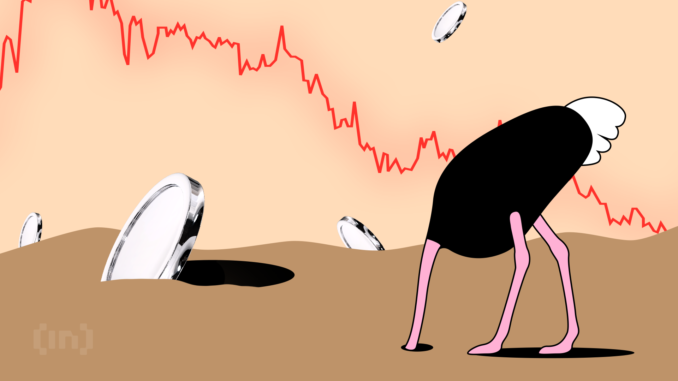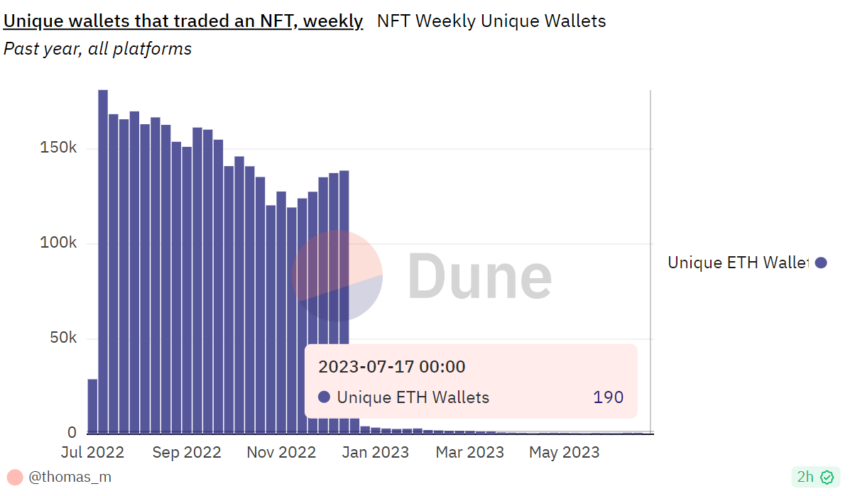
[ad_1]
The speculative NFT market is arguably in the worst shape ever, with almost no traders actively participating in the market. Is the trade-for-profit era of the NFT over? And does the Web3 community, and its companies, need to reimagine how they see their digital collectibles?
Things have never looked so bad for non-fungible tokens (NFTs). At least when you consider their purchases and sales.
NFT Market a Tiny Fraction of a Year Ago
In the past seven days, only 190 unique ETH wallets have bought or sold an NFT, according to data from Dune. Compare that to almost a year ago when over 181,000 unique ETH wallets did the same thing.

Cumulative traded NFT volumes have essentially flatlined since early June 2022, reflecting the emptying of the marketplace. With the evaporation of traders, owners of blue-chip NFTs are now struggling to exit their position.
Generally, those that are experiencing the worst headaches are “collectible” profile pictures (PFP) with little to no utility. In a moment of cringe, the market appeared to peak after Paris Hilton’s appearance on Jimmy Fallon to compare their Bored Apes. Since then, it has all been downhill.
Learn about the future of Web3 gaming with our handy guide: Blockchain Gaming: The Keys to the Metaverse Castle
Yet executives see hope in a move away from speculative, generative PFPs, toward tokens that provide what other technologies cannot. This year, Ticketmaster has dabbled in NFTs for their events, and NFT ticketing alternatives are still raising millions in funding.
Applying NFTs to games, or digital identity, has long been considered a growth area for the tech. However, the consensus is forming (if not already formed) that the halcyon days of large-scale, speculative NFT trading are over.
It’s not just NFTs that appear to be on the long-term decline. (Although the industry outside of speculative digital collectibles appears to be faring somewhat better.) According to a new report by Galaxy Digital, VC investment in crypto has fallen for a fifth straight quarter as money has shifted from Web3 toward artificial intelligence (AI).
Are Games and Tickets Coming to the Rescue?
Modeo Cheng, lead game designer for Curio Research, believes NFTs will find their niche when they have utility in games.
“Right now, a large chunk of NFTs are primarily used for speculation. It’s unlikely that many will endure. However, I envision a future where practical crypto applications encouraging on-chain interactions could significantly amplify their value,” Cheng told BeInCrypto.
Brian D. Evans, the CEO and founder of BDE Ventures, a Web3 studio and advisory firm, is surprised the collapse is taking place during a period of relative health for other cryptos.
“As the fungible, like Bitcoin, Ethereum, Solana, and others surge, NFTs are going in the opposite direction,” he observed.
Although, unlike many other observers, Evans believes PFP projects are down but not out. Evans explicitly said that he does not believe PFP NFTs are a thing of the past.
“What will likely happen is that as the fungible coins continue to go up, people will take profits and then recycle that fresh capital further along the risk curve. And this will likely mean more money flowing to new and solid PFP projects down the line,” Evans said.
But it will not happen overnight.
The post The NFT Bubble Has Burst: Time for a Rethink? appeared first on BeInCrypto.
[ad_2]
Source link




